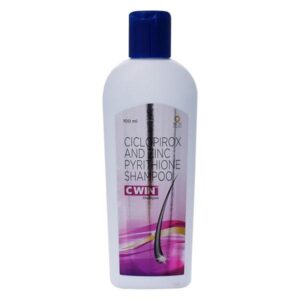CICLOPIROX OLAMINE + PYRITHIONE ZINC
Ciclopirox Olamine: Ciclopirox Olamine is an antifungal medication that is used to treat various fungal infections. It is available in the form of a topical cream, lotion, or shampoo.
Mechanism of Action:
Ciclopirox Olamine works by inhibiting the growth of fungi. It does this by interfering with the production of fungal cell membranes, leading to the disruption of essential cellular processes. This results in the death of the fungal cells and helps in clearing the infection.
Use:
Ciclopirox Olamine is primarily used to treat fungal infections of the skin, such as athlete’s foot (tinea pedis), ringworm (tinea corporis), and jock itch (tinea cruris). It can also be used to treat fungal infections of the nails (onychomycosis).
Dose:
The recommended dose of Ciclopirox Olamine varies depending on the formulation and the type and severity of the infection. It is best to follow the instructions provided by the healthcare professional and to use the medication as directed. Generally, it is applied topically to the affected area once or twice daily for several weeks.
Side Effects:
Common side effects of Ciclopirox Olamine include skin irritation, itching, burning, stinging, redness, or dryness at the application site. These side effects are usually mild and transient. If severe irritation or allergic reactions occur, it is important to discontinue the use of the medication and seek medical attention.
It is important to note that Ciclopirox Olamine is generally well-tolerated, but individual responses may vary. It is always recommended to consult a healthcare professional before starting any new medication to ensure proper use and minimize the risk of side effects.
Pyrithione Zinc: Pyrithione Zinc is an active ingredient found in various over-the-counter anti-dandruff shampoos and treatments. It is primarily used to treat dandruff and seborrheic dermatitis, a common scalp condition characterized by flaking, itching, and redness.
The exact mechanism of action of Pyrithione Zinc is not fully understood, but it is believed to primarily work by inhibiting the growth of yeast-like fungi called Malassezia, that are commonly associated with dandruff and seborrheic dermatitis. Pyrithione Zinc has both antifungal and antibacterial properties, helping to control the overgrowth of these microorganisms on the scalp.
When using a Pyrithione Zinc-containing product, the recommended dose and usage varies depending on the specific product and brand. Generally, it is recommended to use the product 2-3 times a week, leaving it on the scalp for a few minutes before rinsing out thoroughly. It is important to follow the instructions provided on the product label or consult with a healthcare professional for proper usage guidance.
Overall, Pyrithione Zinc is considered safe for topical use and side effects are generally mild and uncommon. However, some individuals may experience scalp irritation, redness, or a burning sensation. In rare cases, an allergic reaction may occur, characterized by rash, swelling, or difficulty breathing. If any severe side effects occur, it is advisable to discontinue use and seek medical attention immediately.
It is worth noting that although Pyrithione Zinc is primarily used for scalp conditions, it may also be found in some formulations for other skin conditions like psoriasis, eczema, and acne. In these cases, the usage instructions and application area may differ, so it is crucial to carefully read and follow the instructions provided by the specific product.

